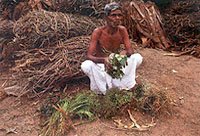 In the ancient times this land was ruled by the Rajas of the Veda tribe. In later times, Wayanad came under the rule of Pazhassi Rajahs of Kottayam royal dynasty. When Hyder Ali became the ruler of Mysore, he invaded Wayanad and brought it under his way. In the days of Tipu, Wayanad was restored to the Kottayam royal dynasty. But Tipu handled entire Malabar to the British after the Sreerandapattam truce that he made with them. This was followed by fierce encounters between the British and Kerala Varma Pazhassi Rajah of Kottayam. Even when the Rajah was driven to the wilderness of Wayanad he waged several battles with his Nair and Kurichia-Kuruma tribal soliders against the British troops and defeated the latter several times through guerilla type encounters. In the ancient times this land was ruled by the Rajas of the Veda tribe. In later times, Wayanad came under the rule of Pazhassi Rajahs of Kottayam royal dynasty. When Hyder Ali became the ruler of Mysore, he invaded Wayanad and brought it under his way. In the days of Tipu, Wayanad was restored to the Kottayam royal dynasty. But Tipu handled entire Malabar to the British after the Sreerandapattam truce that he made with them. This was followed by fierce encounters between the British and Kerala Varma Pazhassi Rajah of Kottayam. Even when the Rajah was driven to the wilderness of Wayanad he waged several battles with his Nair and Kurichia-Kuruma tribal soliders against the British troops and defeated the latter several times through guerilla type encounters.
|
When the state of Kerala was formed in 1956, Wayanad was part of Kannur district. Later South Wayanad was added to Kozhikode district and then on November 1, 1980 North and South Wayanad joined together to form the present Wayanad district.
This mountain district is in many ways the most picturesque in the state, with its rolling hills covered with tropical rainforest. Wayanad also contributes richly to its fortunes.
|
This high altitude district is characterised by the cultivation of perennial plantation crops and spices. The major plantation crops include coffee, tea, pepper, cardamom and rubber. Coffee based farming system is a notable feature of Wayanad.  Coffee is grown both as pure crop and as mixed crop along with pepper. Pepper is grown largely along with coffee in the north eastern parts of the district, especially in Pulpally and Mullankolly areas. Coffee in Wayanad (66,999 ha.) shares 33.65 per cent of the total cropped area in the district and 78 per cent of the coffee area in the state. Other major crops are rubber(63,015 ha.), coconut(59,452 ha.), cardamom (38,348 ha.), tea (31,792 ha.) cassava and ginger. A recent increase in the area under coconut cultivation is noticed in the lower elevations. Paddy is cultivated in 22,772 hectares of land. The rice fields of Wayanad are in the valleys formed by hillocks and in majority of paddy lands, only a single crop is harvested. Ginger cultivation in Wayanad has also substantially increased in recent times and the ginger produced is mainly marketed in the form of green ginger. Homestead farming assumes importance in this district.. Coffee is grown both as pure crop and as mixed crop along with pepper. Pepper is grown largely along with coffee in the north eastern parts of the district, especially in Pulpally and Mullankolly areas. Coffee in Wayanad (66,999 ha.) shares 33.65 per cent of the total cropped area in the district and 78 per cent of the coffee area in the state. Other major crops are rubber(63,015 ha.), coconut(59,452 ha.), cardamom (38,348 ha.), tea (31,792 ha.) cassava and ginger. A recent increase in the area under coconut cultivation is noticed in the lower elevations. Paddy is cultivated in 22,772 hectares of land. The rice fields of Wayanad are in the valleys formed by hillocks and in majority of paddy lands, only a single crop is harvested. Ginger cultivation in Wayanad has also substantially increased in recent times and the ginger produced is mainly marketed in the form of green ginger. Homestead farming assumes importance in this district.. |